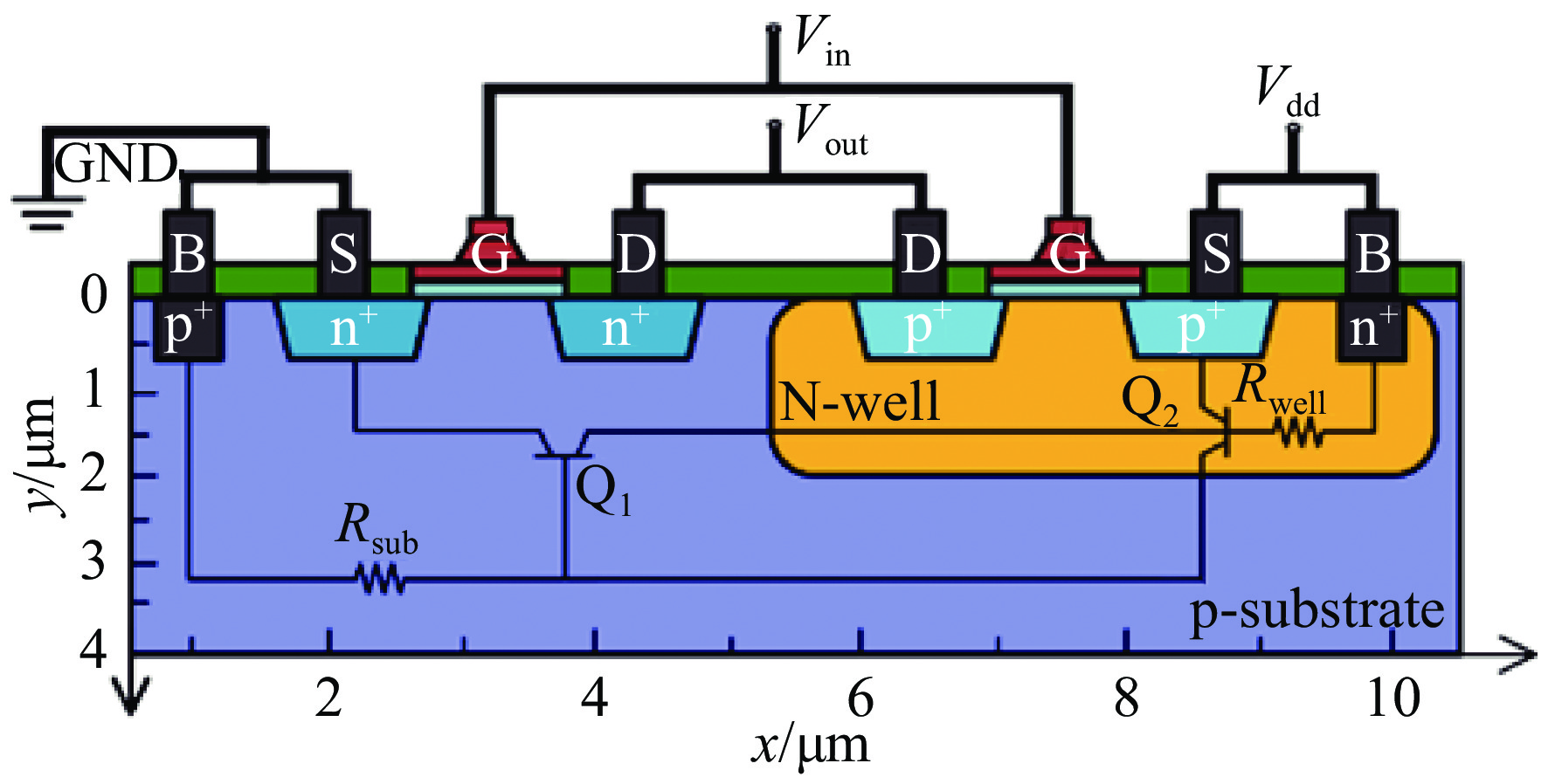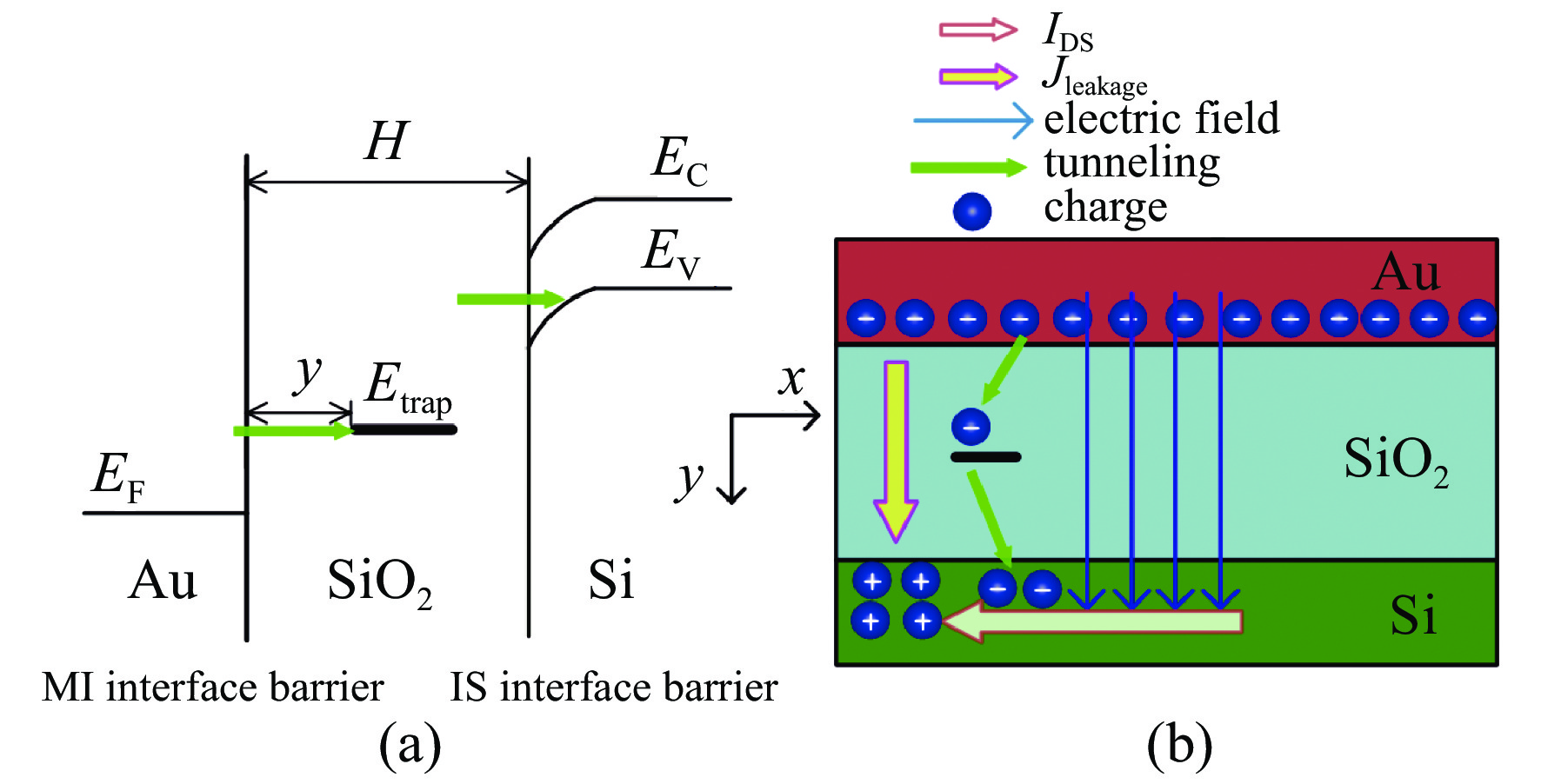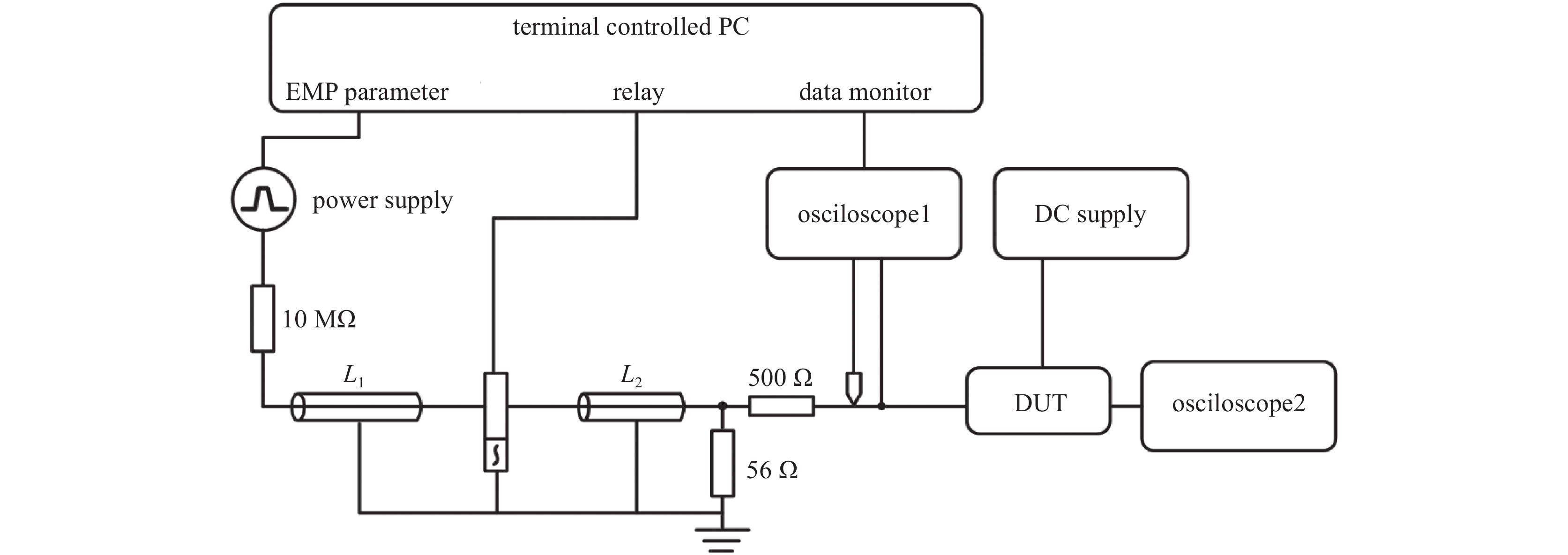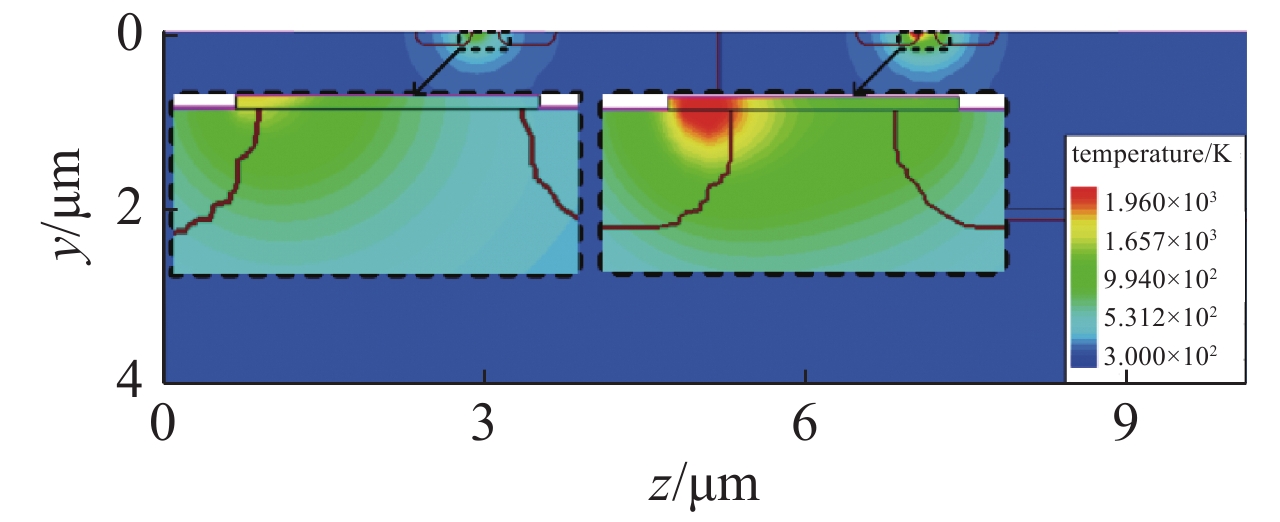Damage characteristics and physical mechanism of the CMOS inverter under fast-rising-edge electromagnetic pulse
-
摘要:
随着电磁环境的日益复杂,保证集成电路(IC)的可靠性成为一个巨大的挑战。在此基础上,通过对CMOS反相器的仿真和实验研究,研究了快上升沿电磁脉冲(EMP)引起的陷阱辅助隧穿(TAT)效应。对此进行了详细的机理分析用于解释其物理损伤过程。EMP感应电场在氧化层中产生陷阱和泄漏电流,从而导致器件的输出退化和热失效。建立了退化和失效的理论模型,以描述输出退化及热积累对EMP特征的依赖性。温度分布函数由半导体中的热传导方程导出。基于TLP测试系统进行的相应实验证实了出现的性能退化,与机理分析一致。Sentaurus TCAD的仿真结果表明,EMP引起的损坏是由栅极氧化层中发生的TAT电流路径引起的,这也是器件的易烧坏位置。此外,还讨论了器件失效与脉冲上升沿的关系。本文的机理分析有助于加强其他半导体器件的EMP可靠性研究,可以对CMOS数字集成电路的EMP加固提出建议。
Abstract:Ensuring the reliability of integrated circuits (ICs) has been a great challenge with the increasing complexity of the electromagnetic environment. On this basis, the fast-rising-edge electromagnetic pulse (EMP)-induced trap-assisted tunneling (TAT) effect is investigated by simulation and experiments of CMOS digital inverters. A detailed mechanism analysis is performed to explain the physical damage process. The EMP-induced field derives traps and leakage current in the oxide, which induces output degradation and thermal failure in the device. A theoretical model of degradation and failure is established to describe the dependency of the output deterioration and the heat accumulation on the EMP resulting signal features. The temperature distribution function is derived from the heat conduction equation in the semiconductor. Corresponding experiments performed based on the TLP test system substantiate the emerging performance deterioration, which is in agreement with the mechanism analysis. Simulated results from the Sentaurus TCAD indicate that EMP resulting voltage-induced damage is caused by the TAT current path occurring in the gate oxide, revealing the location susceptible to burnout. In addition, the dependency of the device failure on the pulse rising time is discussed. The mechanism analysis in this paper facilitates reinforcing the design and promotes EMP reliability research on other semiconductor devices, and the study contributes to the enhancement of EMP robustness in CMOS digital ICs.
-
Key words:
- CMOS inverter /
- electromagnetic pulse /
- trap-assisted tunneling /
- mechanism analysis
-
-
[1] Brauer F, Sabath F, ter Haseborg J L. Susceptibility of IT network systems to interferences by HPEM[C]//Proceedings of 2009 IEEE International Symposium on Electromagnetic Compatibility. IEEE, 2009: 137. [2] Klünder C, ter Haseborg J T. Effects of high-power and transient disturbances on wireless communication systems operating inside the 2.4 GHz ISM band[C]//Proceedings of 2010 IEEE International Symposium on Electromagnetic Compatibility. IEEE, 2010: 359-363. [3] Nitsch D, Camp M, Sabath F, et al. Susceptibility of some electronic equipment to HPEM threats[J]. IEEE Transactions on Electromagnetic Compatibility, 2004, 46(3): 380-389. doi: 10.1109/TEMC.2004.831842 [4] Månsson D, Thottappillil R, Nilsson T, et al. Susceptibility of civilian GPS receivers to electromagnetic radiation[J]. IEEE Transactions on Electromagnetic Compatibility, 2008, 50(2): 434-437. doi: 10.1109/TEMC.2008.921015 [5] Wu Jie, Rosenbaum E. Gate oxide reliability under ESD-like pulse stress[J]. IEEE Transactions on Electron Devices, 2004, 51(9): 1192-1196. [6] Greetsai V N, Kozlovsky A H, Kuvshinnikov V M, et al. Response of long lines to nuclear high-altitude electromagnetic pulse (HEMP)[J]. IEEE Transactions on Electromagnetic Compatibility, 1998, 40(4): 348-354. doi: 10.1109/15.736221 [7] Chahine I, Kadi M, Gaboriaud E, et al. Characterization and modeling of the susceptibility of integrated circuits to conducted electromagnetic disturbances Up to 1 GHz[J]. IEEE Transactions on Electromagnetic Compatibility, 2008, 50(2): 285-293. doi: 10.1109/TEMC.2008.918983 [8] Kim K, Iliadis A A. Impact of microwave interference on dynamic operation and power dissipation of CMOS inverters[J]. IEEE Transactions on Electromagnetic Compatibility, 2007, 49(2): 329-338. doi: 10.1109/TEMC.2007.893333 [9] Kim K, Iliadis A A. Critical bit errors in CMOS digital inverters due to pulsed electromagnetic interference[C]//Proceedings of 2007 International Conference on Electromagnetics in Advanced Applications. IEEE, 2007. [10] Iliadis A A, Kim K. Theoretical foundation for upsets in CMOS circuits due to high-power electromagnetic interference[J]. IEEE Transactions on Device and Materials Reliability, 2010, 10(3): 347-352. doi: 10.1109/TDMR.2010.2050692 [11] You Hailong, Lan Jianchun, Fan Juping, et al. Research on characteristics degradation of n-metal-oxide-semiconductor field-effect transistor induced by hot carrier effect due to high power microwave[J]. Acta Physica Sinica, 2012, 61: 108501. doi: 10.7498/aps.61.108501 [12] Korte S, Camp M, Garbe H. Hardware and software simulation of transient pulse impact on integrated circuits[C]//Proceedings of 2005 International Symposium on Electromagnetic Compatibility. IEEE, 2005. [13] Camp M, Korte S, Garbe H. Classification of the destruction effects in CMOS-devices after impact of fast transient electromagnetic pulses[M]//Sabath F, Mokole E L, Schenk U, et al. Ultra-wideband, short-pulse electromagnetics 7. New York: Springer, 2007. [14] Wang Haiyang, Li Jiayin, Li Hao, et al. Experimental study and SPICE simulation of CMOS inverters LATCH-Up effects due to high power microwave interference[J]. Progress in Electromagnetics Research, 2008, 87: 313-330. doi: 10.2528/PIER08100408 [15] Wang Haiyang, Hu Fei, Hu Biao, et al. Characteristics of microwave breakdown in cavity filter under high power microwave environment[C]//Proceedings of 2020 IEEE MTT-S International Conference on Numerical Electromagnetic and Multiphysics Modeling and Optimization (NEMO). IEEE, 2020. [16] Zhang Yuhang, Chai Changchun, Liu Yang, et al. Modeling and understanding of the thermal failure induced by high power microwave in CMOS inverter[J]. Chinese Physics B, 2017, 26: 058502. doi: 10.1088/1674-1056/26/5/058502 [17] Liang Qishuai, Chai Changchun, Wu Han, et al. Mechanism analysis and thermal damage prediction of high-power microwave radiated CMOS circuits[J]. IEEE Transactions on Device and Materials Reliability, 2021, 21(3): 444-451. doi: 10.1109/TDMR.2021.3104760 [18] Liu Yuqian, Chai Changchun, Zhang Yuhang, et al. Physics-based analysis and simulation model of electromagnetic interference induced soft logic upset in CMOS inverter[J]. Chinese Physics B, 2018, 27: 068505. doi: 10.1088/1674-1056/27/6/068505 [19] Chen Jie, Du Zhengwei. Device simulation studies on latch-up effects in CMOS inverters induced by microwave pulse[J]. Microelectronics Reliability, 2013, 53(3): 371-378. doi: 10.1016/j.microrel.2012.10.012 [20] Liu Yuqian, Chai Changchun, Wu Han, et al. Mechanism of AlGaAs/InGaAs pHEMT nonlinear response under high-power microwave radiation[J]. IEEE Journal of the Electron Devices Society, 2020, 8: 731-737. doi: 10.1109/JEDS.2020.3008816 [21] Zhou Liang, San Zhengwei, Hua Yujie, et al. Investigation on failure mechanisms of GaN HEMT caused by high-power microwave (HPM) pulses[J]. IEEE Transactions on Electromagnetic Compatibility, 2017, 59(3): 902-909. doi: 10.1109/TEMC.2016.2628046 [22] Chai Changchun, Ma Zhenyang, Ren Xingrong, et al. Hardening measures for bipolar transistors against microwave-induced damage[J]. Chinese Physics B, 2013, 22: 068502. doi: 10.1088/1674-1056/22/6/068502 [23] Liu Yang, Chai Changchun, Yu Xinhai, et al. Damage effects and mechanism of the GaN high electron mobility transistor caused by high electromagnetic pulse[J]. Acta Physica Sinica, 2016, 65: 038402. doi: 10.7498/aps.65.038402 [24] Xi Xiaowen, Chai Changchun, Zhao Gang, et al. Damage effect and mechanism of the GaAs pseudomorphic high electron mobility transistor induced by the electromagnetic pulse[J]. Chinese Physics B, 2016, 25: 048503. doi: 10.1088/1674-1056/25/4/048503 [25] Xi Xiaowen, Chai Changchun, Liu Yang, et al. Analysis of the damage threshold of the GaAs pseudomorphic high electron mobility transistor induced by the electromagnetic pulse[J]. Chinese Physics B, 2016, 25: 088504. doi: 10.1088/1674-1056/25/8/088504 [26] Kim K C. High power microwave interference effects on analog and digital circuits in IC’s[D]. Washington, DC: University of Maryland, 2007: 117-130. [27] Zhi Jiang, Zhuang Yiqi, Li Cong, et al. Influence of trap-assisted tunneling on trap-assisted tunneling current in double gate tunnel field-effect transistor[J]. Chinese Physics B, 2016, 25: 027701. doi: 10.1088/1674-1056/25/2/027701 [28] Radasky W A, Baum C E, Wik M W. Introduction to the special issue on high-power electromagnetics (HPEM) and intentional electromagnetic interference (IEMI)[J]. IEEE Transactions on Electromagnetic Compatibility, 2004, 46(3): 314-321. doi: 10.1109/TEMC.2004.831899 [29] Khairurrijal, Noor F A, Sukirno. Modeling of stress-induced leakage current in thin gate oxides[C]. Proceedings of the 9th International Conference on Neural Information Processing. Computational Intelligence for the E-Age. 2002. -





 下载:
下载:










